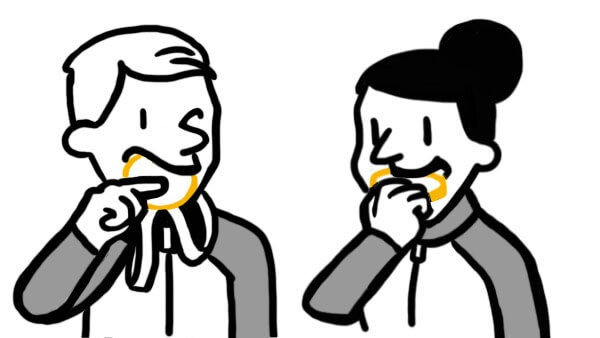Olympians Biting Medals: How a Visual Transcends its Origins, and then Some

In conversation, we regularly use expressions without really knowing their origins. “That’s the ticket,” “put your foot in your mouth,” “bite the bullet”—researching the meanings and origins of these and others can sometimes provide surprising revelations. Visuals have similar long-running tropes that no longer have a clear tie to their origins, and during the Tokyo Olympics, we’re looking today at an image that fits this description perfectly: Olympians biting their medals.
CNN and other sources have lately asked the same question, though CNN showed little interest in the historical origins of the idea. This might be reasonable, considering their answer makes more sense in the visual storytelling of the Olympics and worldwide celebration as a whole: “It’s become an obsession with the photographers,” the network quotes David Wallechinsky.
“I think they look at it as an iconic shot, as something that you can probably sell. I don’t think it’s something the athletes would probably do on their own,” Wallechinsky concludes. It’s a great answer, but it smuggles in another question: why is it an iconic shot that seems saleable?
Dinesh Burad puts some context behind the ‘why’ of medal-biting, reminding us that the practice of biting gold began long ago as a test of purity. Gold, softer than human teeth, would show a bitemark if it was pure. If the piece took a small bitemark but quickly stopped the teeth, merchants knew it was only coated in gold—and that the majority was a harder, less valuable metal.
Okay, but… it’s 2021. Do Olympians really question the purity of their gold medals? And why do they bite non-gold medals too?
One question at a time. Purity-wise, gold medals are exactly what merchants were afraid of when they bit their pieces before accepting them: they’re barely gold at all. Burad details their composition as being “silver and plated with 6g of gold.” So there’s no reason to bite, unless an athlete wants to reaffirm that their gold medal is far more a symbol of accomplishment than a material reward.
And biting silver and bronze? Well, that doesn’t even make the anachronistic/joking sense of biting gold, and as Ryan Lochte learned by chipping a tooth on a silver medal in 2010, it’s not something to do with gusto.
So, what’s going on here? Why is biting a medal “a thing”—one so entrenched in the games that photographers demand it?
It’s visual storytelling at its most transparent. It’s a complex image (person, medal, action, background), but it serves an icon with a clear meaning. And like most icons, its literal meaning is an extremely distant second to its symbolic import.
Biting a medal is an icon of completion. It’s the last part of the process, and seeing it cements the Olympian’s win in our minds. Think of how many times we know the result of an event before the bite image. First, there’s the moment the athlete surpasses the previous time, or gains an impassable lead, or earns an unbeatable score; then, there’s the actual end of the event, when the winner is declared. Then there’s the medal ceremony. Then, there’s the photography. The bite.
The bite image is not only the true end of the win cycle, it’s the time when we see the Olympian as themselves again. During the competition, they’re necessarily focused—zeroed in, tuning out the world. When we see them biting their medal, we get to see them as themselves again (albeit more jubilant than they might ever have been). You don’t see their personality during the events, because personality doesn’t win competitions. The medal bite is our chance to see winners as people again.
Finally, it lets us see a uniquely Olympian moment. Because it is weirdly divorced from its history, because it doesn’t make any real sense, and because so many do not get medals, the photo is appealing to photographers because it’s truly an icon of the Olympics.
Researching the phenomenon, I focused on the two above sources, but every page I looked at repeated one idea: athletes bite medals because photographers ask them to do it. Is there any better evidence that these photos are artifacts of visual storytelling? Initiated by visual storytellers, and sold by those storytellers—to websites, magazines, and television networks, themselves visual storytellers—the pictures are messages of celebration and humanity after trial and hard work.
In the end, we’ve walked quite a path to understand the bite photo: from ‘because it’s universally demanded’ to ‘why would you bite a medal’ to ‘there’s no longer a reason’ to ‘the reason is the image.’ The visual storytelling has taken on a meaning only partially related to history, and more to a modern convention that seems to have essentially created itself.
Visual storytelling can fit any number of motivations, and the clearest motivation for Olympians biting their medals seems to be photographers’ desire to sell photographs of the moment. But the fact that these photographs are saleable means their story is valuable—that the message in that story resonates with people.
In the end, the visual story behind biting the medal really is about proof—a different kind of proof, of course, than the kind sought by merchants centuries ago. The image proves that the athlete won, proves that they’re a normal person celebrating, proves that they’re happy. And, frankly, it proves that the medal is theirs—after all, who’s going to let someone else put their priceless award in their mouth?
